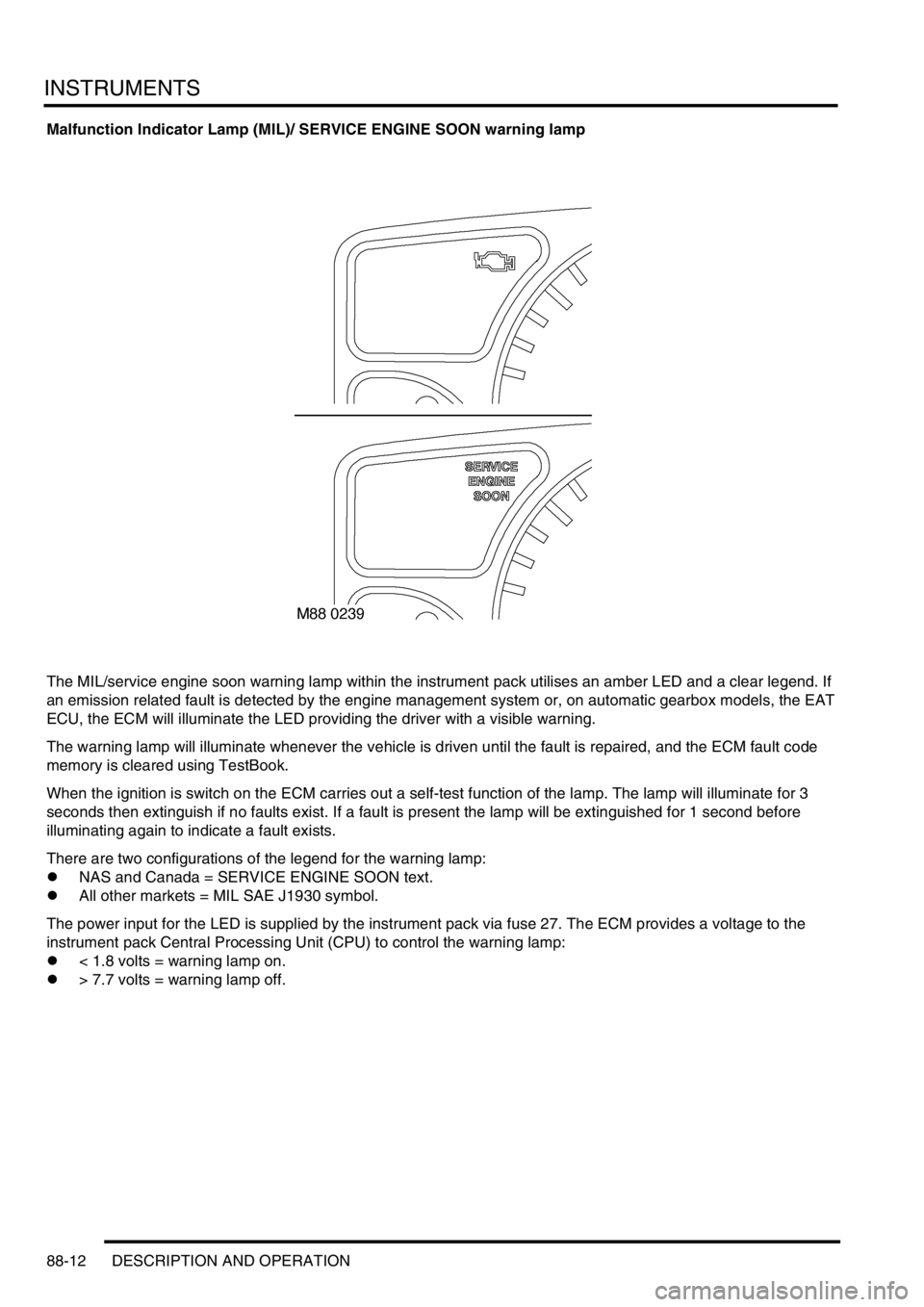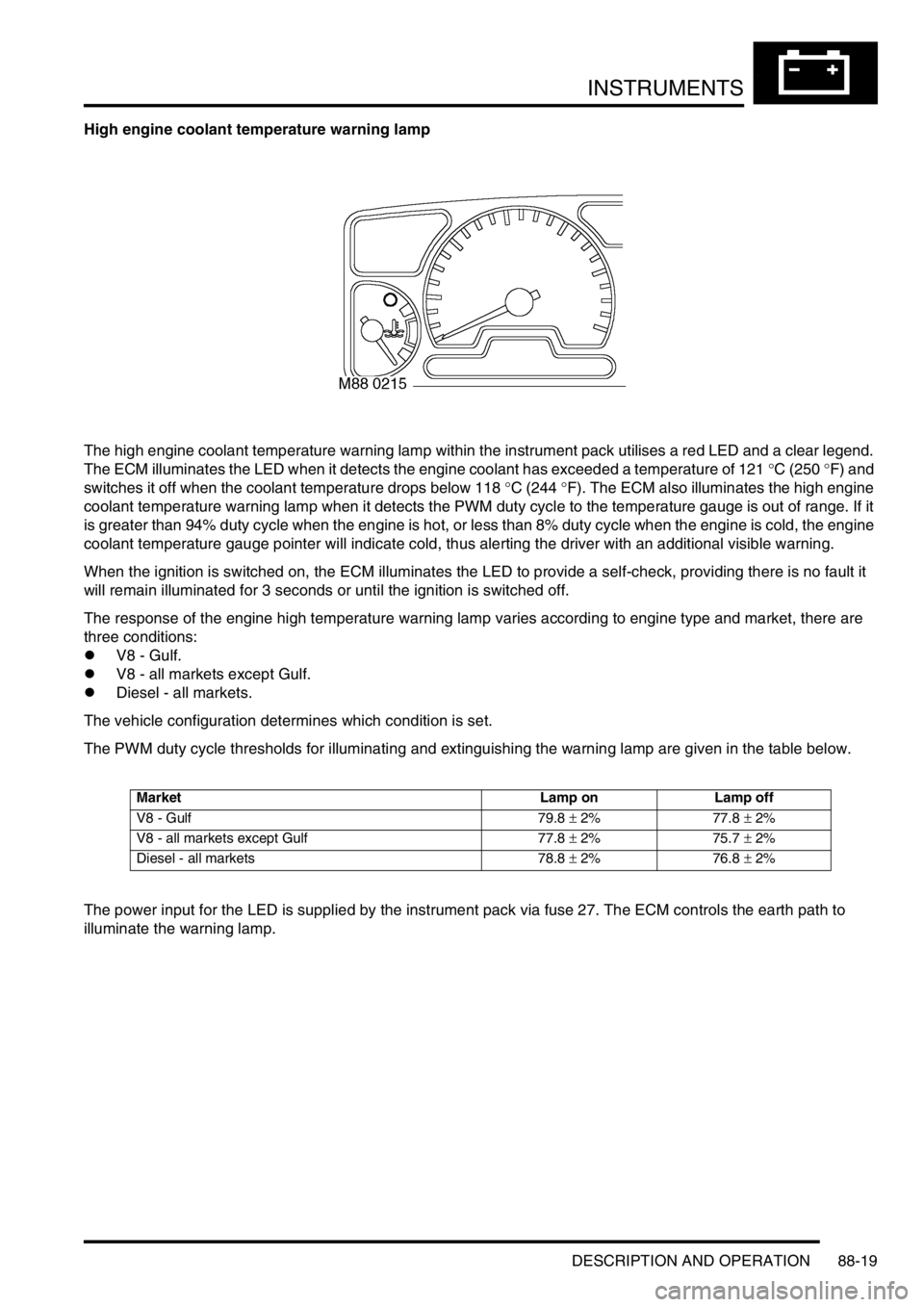Page 1495 of 1529

INSTRUMENTS
88-12 DESCRIPTION AND OPERATION
Malfunction Indicator Lamp (MIL)/ SERVICE ENGINE SOON warning lamp
The MIL/service engine soon warning lamp within the instrument pack utilises an amber LED and a clear legend. If
an emission related fault is detected by the engine management system or, on automatic gearbox models, the EAT
ECU, the ECM will illuminate the LED providing the driver with a visible warning.
The warning lamp will illuminate whenever the vehicle is driven until the fault is repaired, and the ECM fault code
memory is cleared using TestBook.
When the ignition is switch on the ECM carries out a self-test function of the lamp. The lamp will illuminate for 3
seconds then extinguish if no faults exist. If a fault is present the lamp will be extinguished for 1 second before
illuminating again to indicate a fault exists.
There are two configurations of the legend for the warning lamp:
lNAS and Canada = SERVICE ENGINE SOON text.
lAll other markets = MIL SAE J1930 symbol.
The power input for the LED is supplied by the instrument pack via fuse 27. The ECM provides a voltage to the
instrument pack Central Processing Unit (CPU) to control the warning lamp:
l< 1.8 volts = warning lamp on.
l> 7.7 volts = warning lamp off.
Page 1496 of 1529
INSTRUMENTS
DESCRIPTION AND OPERATION 88-13
Transfer box neutral warning lamp
The transfer box neutral warning lamp illuminates to inform the driver that the transfer box is in neutral. The warning
lamp utilises an amber LED with a clear legend which is to ISO design standards. There is no self-check for this
warning lamp. If the transfer box neutral warning lamp is illuminated the audible warning speaker will also chime.
There are two configurations for this warning lamp:
lNAS, Canada and Japan = warning lamp enabled.
lRest of World = warning lamp disabled.
The instrument pack provides the power input and the BCU provides the signal to illuminate the warning lamp. The
transfer box in neutral information is provided by a switch on the transfer box, this sends an analogue signal to the
BCU. The BCU commands the warning lamp on using the serial link to the instrument pack.
Page 1497 of 1529
INSTRUMENTS
88-14 DESCRIPTION AND OPERATION
Overspeed warning lamp
The overspeed warning lamp within the instrument pack utilises an amber LED and a clear legend. The BCU
illuminates the LED when the vehicle speed has exceeded 77 mph (123 km/h) and remains on until the vehicle speed
falls below 74 mph (118 km/h), providing the driver with a visible warning. There is no self-check for this warning lamp.
There are two configurations for this warning lamp:
lGulf = symbol.
lAll other markets = disabled.
The instrument pack provides the power input and the warning lamp is controlled by the instrument pack according
to PWM signal received from the ECM. The road speed information is derived from the SLABS ECU.
The lamp activation thresholds are shown in the table below
Lamp on Lamp off
Input pulse, Hz 165.75 158.83
Road speed, mph (km/h) 77 (123) 74 (118.5)
Page 1499 of 1529
INSTRUMENTS
88-16 DESCRIPTION AND OPERATION
Direction indicator warning lamps
The direction indicator warning lamp within the instrument pack utilises a green LED and a clear legend. The LED
flashes at the same rate as the external indicators, providing the driver with a visible warning.
Operating the left-hand indicator switch instructs the BCU to activate the left-hand indicator warning lamp.
Operating the right indicator switch instructs the BCU to activate the right-hand indicator warning lamp.
There is no self-test performed at ignition on for these warning lamps.
The power input for the LED is supplied by the instrument pack via fuse 27. The earth path for the warning lamps is
from the BCU.
Page 1500 of 1529
INSTRUMENTS
DESCRIPTION AND OPERATION 88-17
Main beam warning lamp
The main beam warning lamp within the instrument pack utilises a clear 14 volt 2 watt long life bulb and a blue legend.
The bulb illuminates when the headlamps are switched to main beam, providing the driver with a visible warning.
There is no self-test performed at ignition on for this warning lamp.
Operating the main beam switch provides the Intelligent Driver Module (IDM) with battery voltage. This feed activates
the IDM to supply the power for the main beam warning lamp. The earth path is provided through the instrument pack.
Page 1501 of 1529
INSTRUMENTS
88-18 DESCRIPTION AND OPERATION
Anti-lock Brake System (ABS) warning lamp
The ABS warning lamp within the instrument pack utilises an amber LED with a clear legend. If a fault within the ABS
is detected, the SLABS ECU illuminates the LED, providing the driver with a visible warning.
When the ignition is switched on, the SLABS ECU illuminates the LED to provide a self-check, providing there is no
fault it will remain illuminated for 3 seconds or until the ignition is switched off. If an ABS fault is detected while driving
the warning lamp will illuminate to alert the driver.
The power input for the LED is supplied by the instrument pack via fuse 27. The SLABS ECU provides the earth path
to illuminate the ABS warning lamp.
Page 1502 of 1529

INSTRUMENTS
DESCRIPTION AND OPERATION 88-19
High engine coolant temperature warning lamp
The high engine coolant temperature warning lamp within the instrument pack utilises a red LED and a clear legend.
The ECM illuminates the LED when it detects the engine coolant has exceeded a temperature of 121 °C (250 °F) and
switches it off when the coolant temperature drops below 118 °C (244 °F). The ECM also illuminates the high engine
coolant temperature warning lamp when it detects the PWM duty cycle to the temperature gauge is out of range. If it
is greater than 94% duty cycle when the engine is hot, or less than 8% duty cycle when the engine is cold, the engine
coolant temperature gauge pointer will indicate cold, thus alerting the driver with an additional visible warning.
When the ignition is switched on, the ECM illuminates the LED to provide a self-check, providing there is no fault it
will remain illuminated for 3 seconds or until the ignition is switched off.
The response of the engine high temperature warning lamp varies according to engine type and market, there are
three conditions:
lV8 - Gulf.
lV8 - all markets except Gulf.
lDiesel - all markets.
The vehicle configuration determines which condition is set.
The PWM duty cycle thresholds for illuminating and extinguishing the warning lamp are given in the table below.
The power input for the LED is supplied by the instrument pack via fuse 27. The ECM controls the earth path to
illuminate the warning lamp.
Market Lamp on Lamp off
V8 - Gulf 79.8 ± 2% 77.8 ± 2%
V8 - all markets except Gulf 77.8 ± 2% 75.7 ± 2%
Diesel - all markets 78.8 ± 2% 76.8 ± 2%
Page 1503 of 1529
INSTRUMENTS
88-20 DESCRIPTION AND OPERATION
Low fuel warning lamp
The low fuel warning lamp within the instrument pack utilises an amber LED and a clear legend. The ECM illuminates
the LED when the fuel gauge pointer has reached 8 degrees from zero. The LED remains illuminated until fuel is
added to move the fuel gauge pointer past 20 degrees from zero. This provides the driver with a visible warning that
the fuel level in the tank is low.
When the ignition is switched on, the ECM illuminates the LED to provide a self-check, providing there is no fault it
will remain illuminated for 3 seconds or until the ignition is switched off.
The sender unit resistance thresholds for switching the lamp on and off are shown in the table below:
The power input for the LED is supplied by the instrument pack via fuse 27. The ECM provides the earth path to
illuminate the warning lamp.
Lamp on Lamp off
Resistance, ohms 158 ± 8 113 ± 6
Fuel gauge pointer angle, degrees 8 20